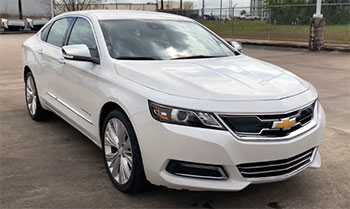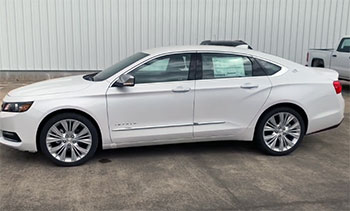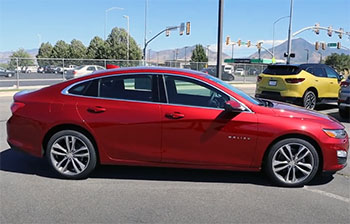I’ve always been a Chevy guy at heart. Growing up, I’d see Impalas cruising the streets with that bold, commanding presence, while Malibus zipped by with their sleek, practical vibe. So, when it came time to choose my next sedan, I found myself torn between these two Chevy classics.
The Chevrolet Impala and Malibu are both stellar vehicles, but they cater to different needs. In this article, I’ll walk you through my journey comparing these two, breaking down their features, performance, and value to help you decide which one fits your lifestyle best. Let’s get started.
Comparison Table: Chevrolet Impala vs. Chevrolet Malibu
| Feature | Chevrolet Impala (2020) | Chevrolet Malibu (2024) |
|---|---|---|
| Size Class | Full-size sedan | Midsize sedan |
| Starting MSRP | $31,620 | $24,700 |
| Base Engine | 3.6L V6 (305 hp, 264 lb-ft torque) | 1.5L Turbo 4-cylinder (160 hp, 184 lb-ft torque) |
| Optional Engine | 2.5L 4-cylinder (197 hp, 186 lb-ft torque) | 2.0L Turbo 4-cylinder (250 hp, 260 lb-ft torque) |
| Fuel Economy (City/Hwy) | 19/28 MPG (V6) | 29/36 MPG (1.5L) |
| Passenger Volume | 105 cu ft | 102.9 cu ft |
| Cargo Volume | 18.8 cu ft | 15.7 cu ft |
| Infotainment | 8-inch touchscreen, Apple CarPlay, Android Auto | 8-inch touchscreen, Apple CarPlay, Android Auto |
| Safety Features | 10 airbags, Rear Cross Traffic Alert, optional Adaptive Cruise Control | 10 airbags, optional Intellibeam Headlamps, Automatic Parking Assist |
| Reliability Rating | 8.5/10 (iSeeCars) | 8.2/10 (iSeeCars) |
| Warranty | 3-yr/36,000-mile basic, 5-yr/60,000-mile powertrain | 3-yr/36,000-mile basic, 5-yr/60,000-mile powertrain |
My Experience With the Chevrolet Impala

Sliding into the 2020 Chevrolet Impala felt like stepping into a rolling lounge.
This full-size sedan, stretching 201.3 inches, has a bold, almost regal presence with its chrome-trimmed grille and sculpted headlights.
It’s the kind of car that turns heads at a stoplight. I took it for a weekend test drive, mixing city streets, open highways, and even some winding backroads.
The standard 3.6L V6 engine, with its 305 horsepower and 264 lb-ft of torque, gave me a thrill every time I punched the gas to merge onto the freeway.
The six-speed automatic transmission shifted smoothly, and the suspension soaked up bumps, making long drives feel effortless. I cranked up the optional Bose audio system, and it filled the cabin with crisp sound, perfect for my road trip playlist.
The Impala’s interior is a standout. With 105 cubic feet of passenger space, I felt like I had room to breathe, and my buddies in the back—two of whom are over six feet tall—didn’t complain about the 39.8 inches of rear legroom.
The 18.8-cubic-foot trunk was a lifesaver when I packed for a camping trip, easily swallowing tents, coolers, and duffel bags. The 8-inch touchscreen with Chevrolet’s MyLink system was intuitive, syncing with my iPhone for Apple CarPlay in seconds. I also appreciated the dual-zone climate control and power-adjustable seats, which made every drive feel tailored to me.
But the Impala isn’t flawless. Its fuel economy—19 city/28 highway MPG with the V6—hit my wallet harder than I expected, especially with gas prices creeping up. Parking in tight urban lots was a challenge due to its size, and I wished I’d opted for the parking assist feature.
The base price of $31,620 felt steep compared to the Malibu, and knowing Chevy discontinued the Impala after 2020 made me worry about future maintenance costs. Still, the Impala’s blend of power, space, and luxury made it feel like a premium choice for someone who values comfort and presence.
Read More: My Thoughts On GMC Terrain Vs. Ford Escape
Pros Of the Chevrolet Impala

- Roomy Interior: The Impala’s 105 cubic feet of passenger space is a game-changer. With 45.8 inches of front legroom and 39.8 inches in the rear, I could stretch out, and my passengers never felt cramped, even on a three-hour road trip with five adults.
- Massive Trunk: The 18.8-cubic-foot trunk is a cavern. I loaded it with camping gear, groceries, and even a spare tire for a friend’s car without breaking a sweat. The 60/40 split-folding rear seats added versatility for oversized items.
- Robust Performance: The 3.6L V6’s 305 horsepower gave the Impala a lively, confident feel. I loved how effortlessly it accelerated on highways, making passing slower traffic a breeze. Even the optional 2.5L 4-cylinder (197 hp) felt peppy enough for city driving.
- Premium Features: The 8-inch touchscreen with Apple CarPlay and Android Auto was a joy to use, syncing flawlessly with my phone. The optional Bose audio system and leather upholstery on the Premier trim made the cabin feel like a luxury car.
- Reliability: With an iSeeCars rating of 8.5/10 and a potential lifespan of 230,000 miles, the Impala feels built to last. I spoke to a coworker who’s driven his 2017 model to 180,000 miles with only routine maintenance.
- Safety Suite: Ten airbags, Rear Cross Traffic Alert, and optional Adaptive Cruise Control gave me confidence. I tested the Lane Change Alert on a busy freeway and felt safer knowing it had my back.
- Sophisticated Styling: The Impala’s sleek lines, chrome accents, and 19-inch wheels (on Premier) gave it a high-end look. I got compliments from friends who thought it looked pricier than it was.
- Comfortable Ride: The suspension smoothed out rough roads, and the quiet cabin made long drives relaxing. I drove 200 miles in one stretch and stepped out feeling fresh, thanks to the supportive seats.
Cons Of the Chevrolet Impala
- Thirsty Engine: The V6’s 19/28 MPG (city/highway) was a pain point. I spent about $60 a week on gas during my test drive, which added up fast compared to more efficient sedans.
- Discontinued Production: Chevy axed the Impala after 2020, which raised red flags for me. Finding parts or specialized service could get tricky (and pricey) years down the line.
- Cumbersome Size: At 201.3 inches long, the Impala felt unwieldy in tight spaces. I struggled to parallel park in my city’s crowded downtown without the optional parking assist.
- Pricey Base Model: The $31,620 starting price is steep for a non-luxury sedan. I found myself comparing it to competitors like the Toyota Avalon, which offer similar features for less.
- Base Trim Shortfalls: The LS trim lacks premium touches like leather seats or a power passenger seat. I felt shortchanged until I stepped up to the LT or Premier trims, which pushed the price higher.
- Wide Turning Radius: The Impala’s 38.8-foot turning radius made U-turns and sharp corners feel less agile than I’d hoped. It took some finesse to navigate narrow streets.
- Depreciation: iSeeCars notes the Impala loses 51.3% of its value in five years. This made me question its long-term financial sense, especially if I planned to sell it later.
- No Hybrid Option: Unlike some competitors, the Impala lacks a hybrid variant. I envied the fuel savings of hybrid sedans like the Honda Accord during my test.
My Experience With the Chevrolet Malibu

The 2024 Chevrolet Malibu, Chevy’s midsize contender, caught my eye with its sporty, modern design.
Its tapered roofline and bold grille give it a youthful edge, and at 194.2 inches long, it’s noticeably easier to handle than the Impala.
I took a Malibu LT out for a week, driving through city traffic, suburban neighborhoods, and a stretch of highway.
The base 1.5L turbo 4-cylinder engine (160 horsepower, 184 lb-ft torque) paired with a continuously variable transmission (CVT) felt smooth but lacked the Impala’s gusto.
Still, its 29/36 MPG (city/highway) was a revelation—I barely touched $30 for gas that week.
The Malibu’s interior, with 102.9 cubic feet of passenger space, was cozy but sufficient for me and three friends. The 15.7-cubic-foot trunk handled my weekly grocery runs, though its high bumper made loading heavy items a bit awkward.
The 8-inch touchscreen with Apple CarPlay and Android Auto was as user-friendly as the Impala’s, and I loved the optional Wi-Fi hotspot for streaming on road trips. The optional Intellibeam Headlamps and Automatic Parking Assist were lifesavers in a stormy evening commute, guiding me through low visibility and a cramped parking garage.
However, the Malibu’s base engine felt underpowered when I needed to pass a slow truck on the highway—it took a moment to build momentum. The interior, while functional, used some cheaper plastics that dulled the experience compared to the Impala’s upscale cabin.
The Malibu’s starting price of $24,700 is a steal, but fully loaded trims (like the 2LT with the 2.0L engine) can hit $32,000, making it less of a bargain. Still, its nimble handling and fuel efficiency made it a practical choice for my daily grind.
Pros Of the Chevrolet Malibu
- Excellent Fuel Economy: The 1.5L turbo’s 29/36 MPG (city/highway) was a budget-saver. I spent less than $30 on gas for a week of mixed driving, perfect for my 30-mile commute.
- Affordable Entry Price: Starting at $24,700, the Malibu is a wallet-friendly option. I found local dealers offering incentives that dropped the price closer to $23,000, a steal for a midsize sedan.
- Nimble Handling: At 194.2 inches, the Malibu felt agile in city traffic. I zipped through tight streets and parked effortlessly, especially with the optional Automatic Parking Assist.
- Tech-Savvy Cabin: The 8-inch touchscreen with Apple CarPlay and Android Auto was a breeze to use. The optional Wi-Fi hotspot kept my passengers entertained on a group trip.
- Ongoing Production: The Malibu’s current production status reassured me about parts availability. I checked with a Chevy service center, and they confirmed easy access to maintenance items.
- Safety Features: Ten airbags, optional Forward Collision Warning, and Intellibeam Headlamps boosted my confidence. I tested the Lane Keep Assist and appreciated its gentle nudges on curvy roads.
- Better Resale Value: Retaining 56.3% of its value after five years (per iSeeCars), the Malibu holds up better than the Impala, which eased my mind about future trade-ins.
- Modern Design: The Malibu’s sleek grille and aerodynamic shape gave it a fresh, sporty look. I got nods of approval from coworkers who liked its contemporary vibe.
Cons Of the Chevrolet Malibu
- Weak Base Engine: The 1.5L’s 160 horsepower felt sluggish during highway passes. I had to plan overtakes carefully, which was frustrating compared to the Impala’s power.
- Smaller Interior: With 102.9 cubic feet of passenger space and 38.1 inches of rear legroom, the Malibu felt tighter. My taller friends noticed the snug fit on a long drive.
- Mediocre Interior Materials: The cabin’s hard plastics, especially in the base L trim, felt cheap. I expected a bit more refinement for a car pushing $30,000 in higher trims.
- Trunk Limitations: The 15.7-cubic-foot trunk’s high bumper and narrow opening made loading bulky items tricky. I struggled to fit a large suitcase without awkward maneuvering.
- Base Trim Tech Gaps: The base L trim skips the MyLink system, forcing me to upgrade to the LS or LT for full connectivity, which bumped the price closer to $27,000.
- Performance Shortfall: The optional 2.0L engine (250 hp) is peppier but still lags behind the Impala’s V6. I missed the raw power during spirited drives on open roads.
- Limited Cargo Versatility: Unlike the Impala, the Malibu’s rear seats don’t fold as flat, limiting space for long items. I couldn’t fit a bike frame as easily as I’d hoped.
- Market Uncertainty: While still in production, Chevy’s focus on SUVs and EVs made me wonder about the Malibu’s future. Rumors of discontinuation gave me slight pause.
Read More: My Thoughts On BMW X7 Vs. Cadillac Escalade
Frequently Asked Questions (FAQ)
It depends on your needs. The Malibu is better for fuel efficiency (29/36 MPG) and affordability ($24,700 starting), ideal for commuters. The Impala offers more space (105 cu ft) and power (305 hp), perfect for families or those wanting a premium feel. Test drive both to see what fits you best.
The Malibu hasn’t been discontinued; it’s still in production as of 2024. However, Chevy has shifted focus to SUVs and electric vehicles, so future discontinuation is possible due to market trends favoring larger vehicles.
Yes, the Impala is reliable, with an iSeeCars rating of 8.5/10 and a potential lifespan of over 230,000 miles. Regular maintenance is key to maximizing its longevity.
The Malibu’s weaknesses include an underpowered base engine (160 hp), less spacious interior (102.9 cu ft), and lower-quality cabin materials. Its trunk design can also be less practical for loading bulky items.
Conclusion: For Chevrolet Impala and Malibu
You can’t go wrong with either the Chevrolet Impala or Malibu, but your choice hinges on what you value most. If you’re like me and crave space, power, and a touch of luxury, the Impala’s roomy cabin, potent V6, and upscale styling make it a fantastic pick—though you’ll pay more at the pump and upfront. If you’re looking for a practical, fuel-efficient daily driver that’s easier on your wallet, the Malibu’s modern design and nimble handling are tough to beat. I recommend taking both for a test drive to feel the difference yourself. Which one speaks to you?

